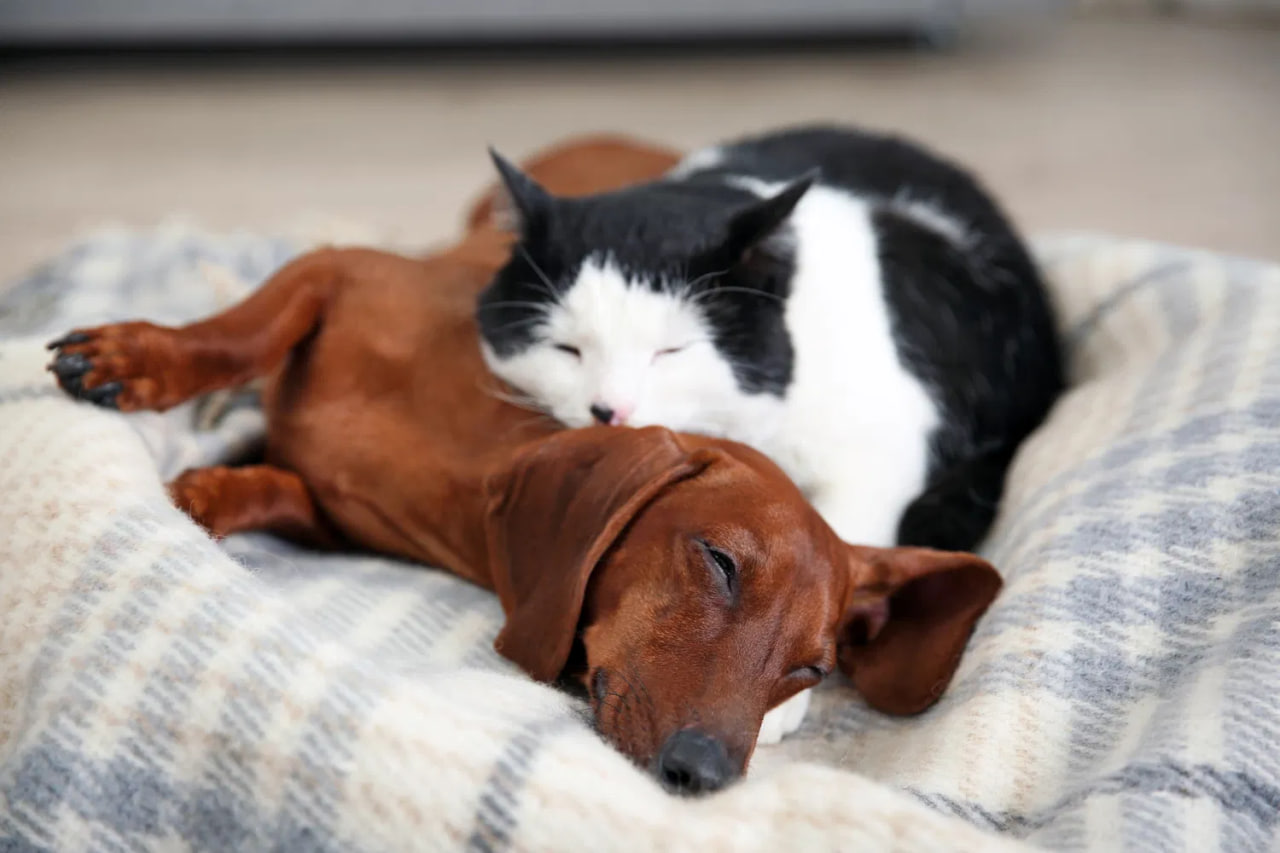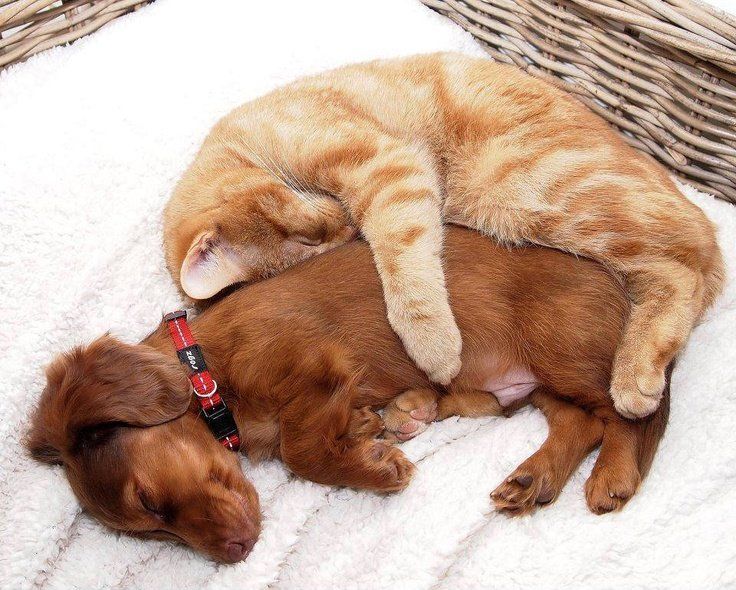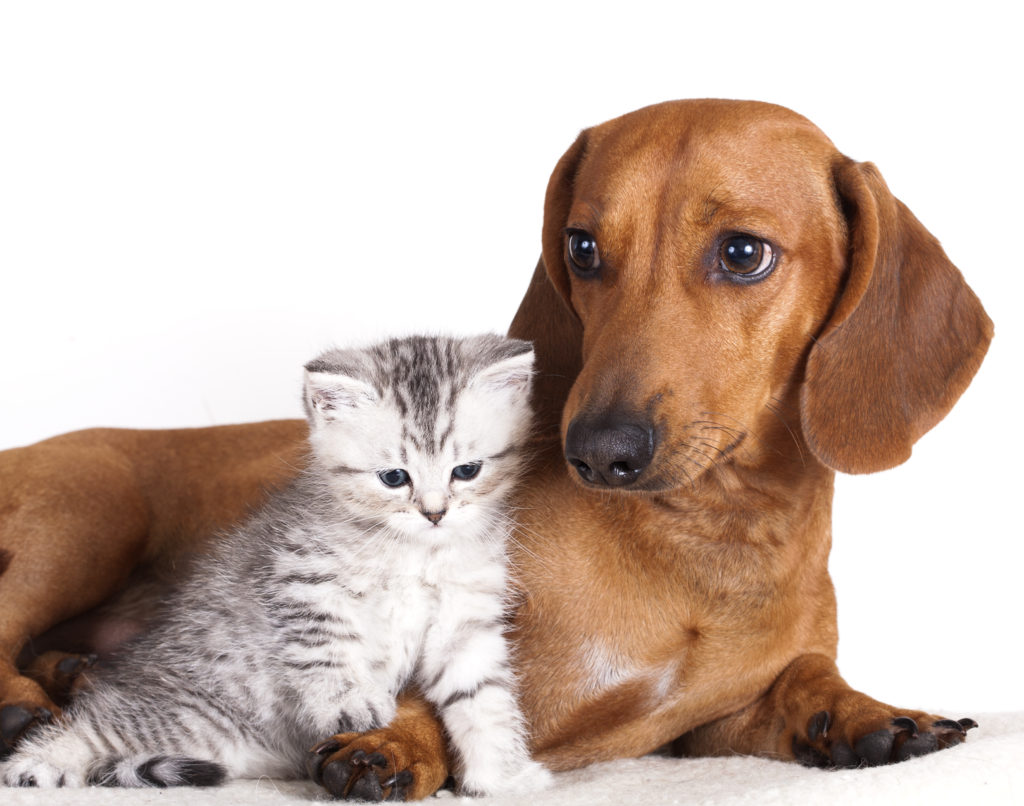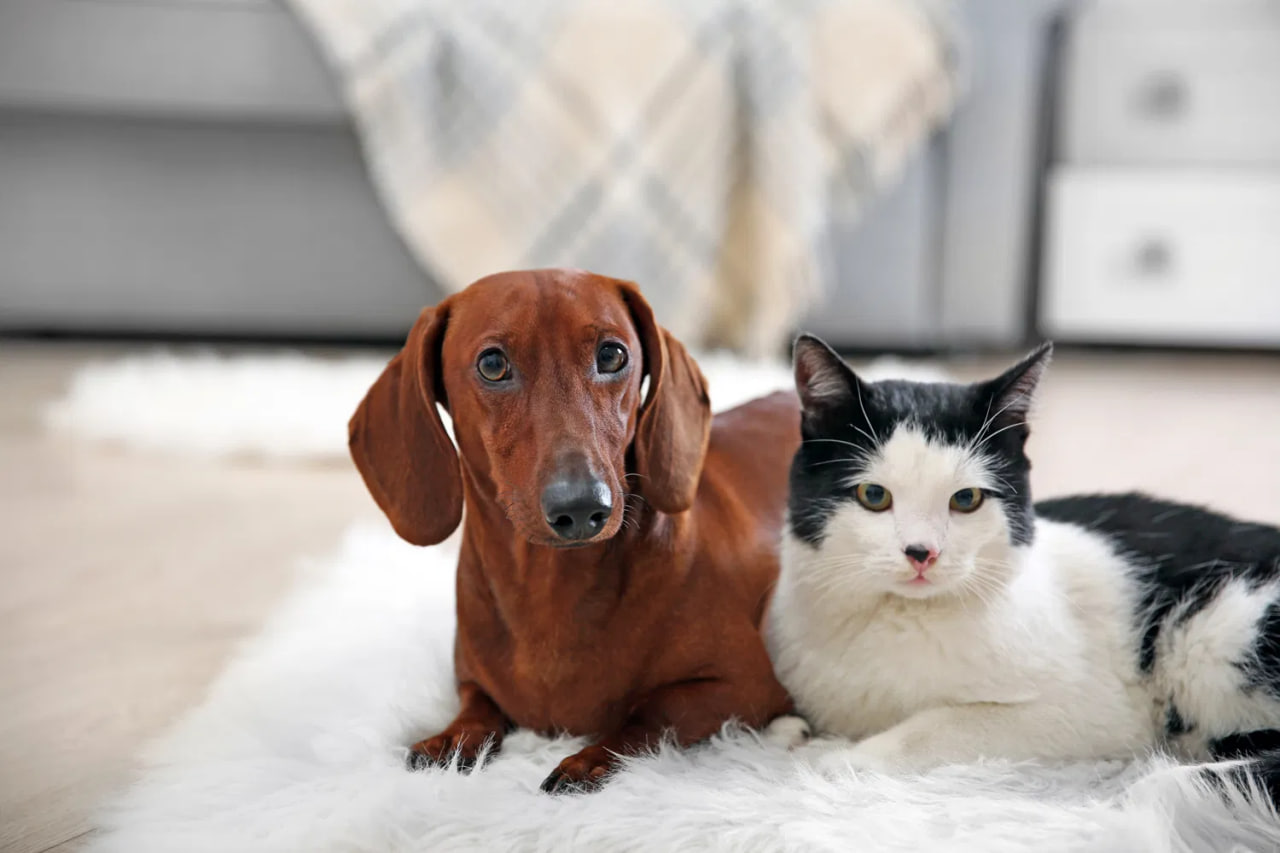Are dachshunds good with cats ? This question often arises for pet owners considering adding a dachshund to a household that already includes a feline companion. Dachshunds, known for their distinctive long bodies and lively personalities, can indeed coexist peacefully with cats under the right circumstances. Understanding their temperament, training needs, and how to introduce them to cats can significantly influence their relationship dynamics. In this article, we explore whether Dachshunds are good with cats, practical tips for fostering a harmonious environment, and effective training techniques to encourage positive interactions between these two beloved pets.

Are Dachshunds Good with Cats?
The Dachshund is generally a sociable, joyful, and extroverted dog breed that forms strong bonds with its human companions and other animals. This characteristic makes the Dachshund an excellent choice for cohabiting with a cat, as they are naturally amiable and open to sharing their living environment.
It is important to remember that every dog is an individual. While some Dachshunds will willingly coexist with one or several cats, others might have difficulties adapting to life with feline companions.
Early socialization and familiarizing your Dachshund with cats during their formative years are crucial for ensuring a harmonious relationship between your pets. Fortunately, due to their pleasant temperament, there is a high likelihood that your Dachshund will develop a positive rapport with cats.
However, Dachshunds were originally bred for hunting badgers, and some still possess strong hunting and prey instincts. For Dachshunds with a pronounced hunting drive, cohabiting with cats could be challenging, particularly once they reach adulthood.

Factors Affecting Dachshund-Cat Compatibility
Several key factors influence the success of a dachshund-cat relationship:
A. Age of Introduction
Introducing a dachshund and a cat at a younger age tends to yield better results because both animals are more adaptable and less entrenched in their habits. Puppies and kittens are naturally curious and open to new experiences, which can help them form bonds more easily. Older pets may have established behaviors that could potentially lead to conflicts if not properly managed.
B. Personal Characteristics of Both Pets
The individual temperaments of the dachshund and the cat are critical factors in determining compatibility. A dachshund with a calm, friendly, and well-socialized disposition is more likely to accept a feline companion peacefully. On the other hand, if the dachshund is anxious, aggressive, or overly territorial, it may pose challenges to a harmonious relationship with a cat.
Similarly, the cat’s personality matters greatly. Cats that are confident, outgoing, and tolerant of other animals are more likely to adapt well to living with a dachshund. Shy or skittish cats might find the presence of an energetic dachshund intimidating or stressful.
C. Previous Experiences with Other Animals
The past interactions of both the dachshund and the cat with other animals can significantly influence their behavior towards each other. Positive experiences with different species can promote a more accepting attitude and smoother introductions. For example, if a dachshund has been raised around cats from a young age and had positive interactions, it is more likely to be receptive to a new feline friend.
Conversely, negative experiences, such as previous conflicts or lack of exposure to other species, may result in fear, aggression, or territorial behavior. In such cases, gradual introductions and patient socialization efforts become crucial to foster a positive relationship between a dachshund and a cat.
D. Consideration of Living Environment and Space
Providing adequate living space and resources is essential for reducing potential conflicts over territory and ensuring both pets have their own safe areas to retreat to. Cats, in particular, value vertical space for climbing and observing, while dachshunds appreciate having cozy spots and toys that cater to their natural instincts.
It’s important to create a harmonious environment where both pets feel secure and have opportunities for individual space and enrichment. This can help prevent stress-related behaviors and promote a more peaceful coexistence between a dachshund and a cat.
In conclusion, successful integration of a dachshund and a cat depends on careful consideration of their ages at introduction, their individual personalities, their previous experiences with other animals, and the quality of their living environment. By addressing these factors thoughtfully and proactively, pet owners can maximize the likelihood of a positive and fulfilling relationship between their dachshund and cat.

How to Introduce Your Cat and Dachshund
If you’re considering housing a Dachshund and a feline together, and your Dachshund is already an adult, the following instructions will guide you through the process effectively. Note that the dynamics may shift if you’re introducing an adult cat to a Dachshund, as mature felines have already developed distinct personalities.
- It’s crucial to have a well-disciplined Dachshund that responds to commands such as “sit,” “stay,” and “down.”
- Ensure that both pets are up-to-date with their vaccinations.
- Establish a “secure zone” for each pet and keep them there for a few days before any formal introductions. This gives them a chance to familiarize themselves with each other’s scent.
- Use a common door to feed your Dachshund on one side and your cat on the other. This arrangement allows them to associate each other’s presence with a positive experience, even though they can’t see each other.
- Once both your cat and Dachshund can peacefully eat on either side of the door, it’s time for a controlled introduction. It’s advisable to keep your Dachshund leashed initially or until both animals exhibit calm and friendly behavior.
- Have rewards ready for both pets to encourage their friendly and tranquil interaction. If you sense any hostility, halt the introduction until the next opportunity and return both pets to their respective secure zones.
- Once they appear to coexist harmoniously, you can release your Dachshund from its leash. If any tension re-emerges, strive to interact calmly, and if necessary, separate them until they settle down.

How to Introduce Your Cat and Dachshund
Common Challenges and Solutions
| Challenge | Solution |
|---|---|
| Chasing behavior | Redirect the dachshund’s attention with toys or treats |
| Territorial disputes | Provide separate feeding areas and multiple litter boxes |
| Resource guarding | Ensure ample resources for both pets and supervise interactions |
| Stress and anxiety | Create safe spaces for each pet and use calming aids if necessary |
Techniques for Training Dogs to Live With Cats
To train a dachshund to live harmoniously with cats, specific techniques can be employed:
A. Basic Dog Obedience Commands
- “Leave it” and “Stay” commands: Teach your dachshund these commands to manage their behavior around cats. “Leave it” helps them to cease or ignore specific stimuli, such as the presence of a cat. “Stay” teaches them to maintain a distance or refrain from approaching the cat when instructed.
- Regular training: It’s crucial to practice these commands consistently, not just when the cat is nearby but in various situations throughout the day. This consistency helps your dachshund understand that “Leave it” and “Stay” commands are always to be followed, regardless of the circumstances.
B. Positive Reinforcement Strategy
- Encourage calm, non-reactive behavior: Reward your dachshund with praise or treats when they exhibit calm and non-reactive behavior around the cat. Positive reinforcement strengthens the association between calm behavior and rewards.
- Patience and persistence: Patience is key during this training process. Your dachshund may take time to learn and adapt to new commands and desired behaviors. Consistent positive reinforcement and persistence in training will help reinforce calm behavior around cats.
C. Redirecting Prey Drives and Unwanted Behaviors
- Provide appropriate outlets for energy: To minimize prey drive, offer your dachshund suitable physical activities and mental stimulation. This may include playtime, running, or digging in a designated area. A tired dachshund is less likely to focus on hunting the cat.
- Promote positive behaviors and discourage unwanted ones: In addition to physical care, use toys and activities that engage your dachshund’s mind. This redirection helps them focus on other activities instead of hunting cats.

Techniques for Training Dogs to Live With Cats
Create a Cat-Friendly Environment for Both Pets
Creating a harmonious living space is crucial for long-term success:
A. Design a Safe Space for Cats
- Install cat trees or shelves for vertical escape routes
- Provide hiding spots throughout the home
B. Arrange Resources Appropriately
- Place litter boxes in quiet, accessible areas
- Separate feeding stations to prevent competition
C. Enrichment Activities for Both Dogs and Cats
Offer species-specific toys and activities to keep both pets mentally and physically stimulated.
FAQs
Q : Are Dachshunds Good with Kids?
A : Yes. Dachshunds can be good companions for children when properly socialized and supervised. They are known for their loyalty and affection towards their families. If the question “are dachshunds good with kids ” has been troubling you, you can rest assured that this breed makes ideal family pets.
However, due to their small size and sometimes feisty temperament, interactions should be monitored to prevent accidental injuries.
Q : What were Dachshunds bred for?
A : Primarily, dachshunds were cultivated to hunt small game, with a special emphasis on badgers and other burrowing animals. Their elongated bodies and persistent temperament were specifically crafted to seek out and chase prey from underground burrows. If you ever wondered, “What were dachshunds bred for?“, that’s the answer.
Q : What if my Dachshund chases my cat?
A : Chasing behavior is natural for Dachshunds due to their hunting instincts. Redirect this behavior by providing mental and physical stimulation through play and training. Consistency in training and patience are key to modifying this behavior.
Q : Can Dachshunds and cats become friends?
A : Yes, with patience and proper introduction, Dachshunds and cats can develop a friendly relationship. Ensure that both pets have their own safe spaces and supervise interactions until you are confident they can coexist peacefully.
Conclusion
The article clarifies the question ” are Dachshunds good with cats ? ” While individual temperament can vary, Dachshunds can generally learn to coexist peacefully with cats through proper training, positive reinforcement, and gradual introductions. Understanding their prey drive tendencies and providing appropriate outlets for their energy are crucial steps in fostering a harmonious relationship between these two pets. By employing patience, consistency in training, and respecting each animal’s unique personality, pet owners can create a household where Dachshunds and cats not only tolerate but also enjoy each other’s company.
To explore more pet care and lifestyle topics, be sure to visit our homepage for a wide selection of helpful articles!

Cuddle Companions is your go-to resource for everything you need to keep your furry friends happy and healthy. We specialize in providing detailed and helpful information about the best foods, treats, and care practices for pets of all kinds. Whether you’re a seasoned pet owner or a new puppy parent, our team of experienced and passionate experts is dedicated to offering reliable advice and recommendations. At Cuddle Companions, we believe that a well-cared-for pet is a happy pet, and we’re here to help you every step of the way. Visit us at [bestdogfoodfordachshunds.net] for more information and resources.

